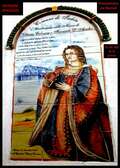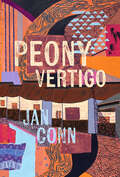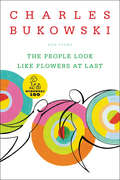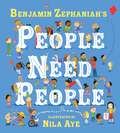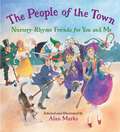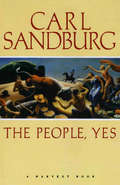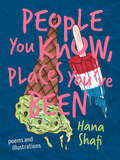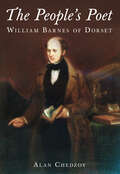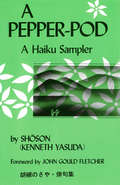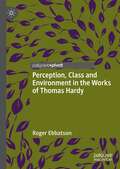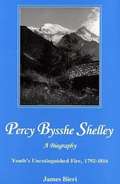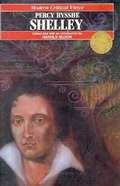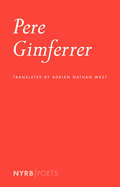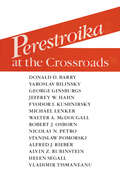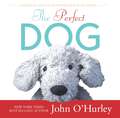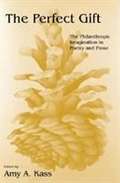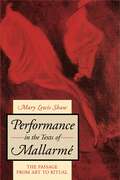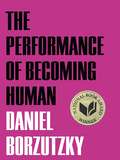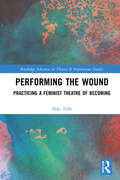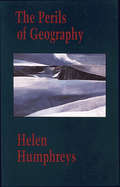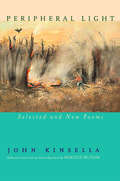- Table View
- List View
Pensamientos en libertad: En las alas de la poesía
by Giovanni FenoglioEl autor en este libro utiliza la poesía para brindarnos un panorama de sus vivencias y para dejarnos sus reflexiones en formato de prosa.
Penumbra: English Poems
by Vinod AsudaniThis book contains 57 English poems from the pen of multilingual poet who has already established himself as one of the significant contemporary literary voices in Sindhi and Hindi languages in Indian sub continent. The poems included in this book deal with a wide range of topics. Some of the poems like Biodiversity, In Search of Bahugana and Broken Toys portray sensibility of the disabled. They authentically depict anguish, agony and perspective of a disable person. Many other things such as disillusionment, fragmentary existence, self alienation, Love, romance, social criticism to appear and reappear in different poems. All these things have been approached from different angle and they unfold in the poems in an unusual manner triggering emotional and intellectual response from the readers. Poems included in this volume make readers to reconsider and redefine many of their notions about affection, relationship, myths, social reality, violence, governance and so on.. Poetry is characterised by psychological realism. Many of the poems operate at different levels and each level is made up of many layers. Hence, sometimes, they make heavy demand on intellect and sensibility of readers to fully decipher their connotation.
Peony Vertigo
by Jan ConnPoems emerging from deep memory and shifting landscapes to joyously engage flora, fauna, and self. In her latest collection, Peony Vertigo, Jan Conn's poetic sensibility disperses and gathers, careens and slides, in and out of relation with the endangered world. Through poems ranging from global to microscopic scales, Conn's beholden, fluid sense of self dissolves into fog and river, and reconstitutes as bright orange newt, prehistoric horse, painter, and mourning daughter. Her voice is vulnerable, ecstatic, and elliptical, a tender exploration of liminal consciousness and the urge to identify with environments in crisis.
People Hanging from Pegs, 1976-81
by Sarvesvara Dayala Saksena Vijay MunshiSahitya Akademi Award-winning collection of Hindi poems.
The People Look Like Flowers At Last
by Charles Bukowskithe gas line is leaking, the bird is gone from the cage, the skyline is dotted with vultures;Benny finally got off the stuff and Betty now has a jobas a waitress; andthe chimney sweep was quite delicate as hegiggled up through the soot.I walked miles through the city and recognizednothing as a giant claw ate at my stomach while the inside of my head felt airy as if I was about to go mad.it's not so much that nothing means anything but more that it keeps meaningnothing,there's no release, just gurus and self-appointed gods and hucksters.the more people say, the less there is to say.even the best books are dry sawdust.--from "fingernails; nostrils; shoelaces"
People Need People
by Benjamin ZephaniahTo walk toTo talk toTo cry and rely on,People will always need people . . .From the creators of Nature Trail comes an uplifting picture book about the power of people, and the importance of connecting with others. This timely poem reminds us all to be kind to one another.Written by legendary poet, Benjamin Zephaniah, one of The Times' top 50 British post-war writers. Beautifully illustrated by Nila Aye.Praise for Nature Trail:A joy to read with small children - Independent
The People of the Town: Nursery-Rhyme Friends for You and Me
by Alan MarksMeet familiar friends and new neighbors in this playful collection of nursery rhymes. On a misty, moisty morning, we meet the snoring old man, and by evening we&’re running through the town with Wee Willie Winkie in his nightgown. A day full of nursery rhyme enchants, delights, and enlightens young readers. Gorgeous illustrations paired with quintessential nursery rhymes introduce familiar friends like Little Bo Peep, Georgie Porgie and the Grand Old Duke of York, as well as meet new neighbors, including Little Polly Flinders, Honest John Boldero and Little Tommy Tucker. An attractive and easily giftable collection of tried and true favorites.
People & Other Aggravations
by Judith ViorstSlim volume of Viorst's humorous poetry. Characters and lifestyle in the late 60s and early 70s. Brief descriptions of each poem's drawing included.
The People, Yes
by Carl SandburgThe acclaimed epic prose-poem from one of America’s greatest poets and the three-time winner of the Pulitzer Prize. A long poem that makes brilliant use of the legends and myths, the tall tales and sayings of America. As Irish poet Padraic Colum said, “The fine thing about The People, Yes is that it is indubitable speech. Here is a man speaking, a man who knows all sorts and conditions of men, who can be wise and witty, stirring and nonsensical with them all. Carl Sandburg is a master of his own medium; he can deliver himself with the extraordinary clarity of the comic strip caption, with the punch of the tip-top editorial, with the jingle of the American ballad. If America has a folksinger today he is Carl Sandburg, a singer who comes out of the prairie soil, who has the prairie inheritance, who can hand back to the people a creation that has scraps of their own insight, humor, and imagination, a singer, it should be added, who both says and sings . . . He has a passion that gives dignity to all he says. It is a passion for humanity, not merely for the man with depths of personality in him, but for the ordinary man and woman . . . The People, Yes is his most appealing volume.”Praise for Carl Sandburg“A poetic genius whose creative power has in no way lessened with the passing years.” —Chicago Tribune“Carl Sandburg was more than the voice of America, more than the poet of its strength and genius. He was America.” — President Lyndon B. Johnson
People You Know, Places You've Been
by Hana ShafiThe latest poetry and artwork collection from Hana Shafi examines the unlikely connections we make to the people and places we encounter. Despite the infinite variations of our lives, every urban dweller has sparred with a neighbour they disliked, seen beautiful strangers on public transit, told secrets to their hairdresser. We interact with these supporting characters on a daily basis—and often we are them for others.Shafi celebrates the Antiheroes of the world (the alcoholic at your local bar, teenage girls); examines those in Beautiful Leading Roles (the hot professor, the rich couple); lauds older generations of Wizards and Crones; and flags the Nemeses (men who think they’re allies, competitors for produce at farmer’s markets). We sink into recognition at depictions of Palaces such as the greasy spoon, Dungeons of public transit, and the Liminal Spaces of checkout counters or waiting rooms (including that one at the end of the cosmos).People You Know, Places You've Been is an insightful, charming collection that offers a sense of shared recognition and nostalgia, ultimately asking: what if seemingly mundane places are actually the foundations of who you are?
The People's Poet: William Barnes of Dorset
by Alan ChedzoyBorn the child of an agricultural labourer in Dorset’s Blackmore Vale, by self-education William Barnes (1801-1886) rose to be a lawyer's clerk, a schoolmaster, a much-loved clergyman, and a scholar who could read over seventy languages. He also became the finest example of an English poet writing in a rural dialect. In this book, Alan Chedzoy shows how, uniquely, he presented the lives of pre-industrial rural people in their own language. He also recounts how Barnes’s linguistic studies enabled him to defend the controversial notion that the dialect of the labouring people of Wessex was the purest form of English. Serving both as an anthology and an account of how the poems came to be written, this biography is essential reading for anyone who wants to discover more about the man who, in an obituary, Thomas Hardy described as ‘probably the most interesting link between present and past life that England possessed’.
A Pepper-Pod: A Haiku Sampler
by Kenneth Yasuda John Gould FletcherThis collection of Japanese haiku profiles noted poet Kenneth Yasuda and is a welcome addition to the world of haiku.<P><P>In the compact, evocative verse-form known as haiku Japanese writers have for centuries been condensing their finest poetic thought and feeling. Adequate translation of haiku into English awaited a Japanese writer fully acquainted with the English language. That writer has now appeared in Kenneth Yasuda, and this book is the result of a long-time labor of love on the finest poetry of his homeland.Readers will have some notion of the delight to be expected from the pages of this book, not the least interesting art of which is the final brief section of haiku written directly in English by Mr. Yasuda himself. He also supplies a scholarly clear, fascinating introductory essay on nature and development of haiku form.
Perception, Class and Environment in the Works of Thomas Hardy
by Roger EbbatsonThis book examines Thomas Hardy’s writing in both prose and poetry, focusing on issues of perception, ‘being’, class and environment. It illustrates the ways in which Hardy represents a social world which serves as a ‘horizon’ for the individual and explores the dialectic between the perceptible world and human consciousness. Ebbatson demonstrates how, in Hardy’s oeuvre, modern life becomes alienated from its roots in rural life – individual freedom is achieved in works like Tess of the d'Urbervilles, Jude the Obscure or The Woodlanders at the cost of personal insecurity and a deepening sense of homelessness. However, this development occurs against the marginalisation of dialect forms of speech. This book also explores how Hardy’s impressionist vision serves to undermine the prevailing conventions of plot structure.
Percy Bysshe Shelley: Youth's Unextinguished Fire, 1792-1816
by James BieriHaving retired from teaching psychology in US universities, Beiri presents a biography of British Romantic poet Shelley (1792-1822), ending with the summer in Switzerland of which so much has been said and imagined. He says the poet compressed into less than three decades a rich legacy of poetry, prose, and correspondence; and though he did not know the work of his contemporary William Blake, the two shared a psychological understanding of humanity that anticipated the age of Freud.
Percy Bysshe Shelley (Modern Critical Views)
by Harold Bloom-- Brings together the best criticism on the most widely read poets, novelists, and playwrights<BR>-- Presents complex critical portraits of the most influential writers in the English-speaking world -- from the English medievalists to contemporary writers
Pere Gimferrer
by Pere GimferrerA bilingual edition of poems by the award-winning Spanish poet.Pere Gimferrer has been writing poetry for more than fifty years in several languages, restoring and expanding upon avant-garde tendencies in poetry that had been abandoned in Spain after the Spanish Civil War. Of his second book, The Sea Aflame, Octavio Paz wrote: &“Our language will be, already is, larger by one poet.&” In 1970, with Mirrors, Gimferrer turned to Catalan, his mother tongue. Since then, he has won major Catalan and Spanish prizes for his work, which, along with poetry, includes writings on film and art history, translations, and novels. This bilingual volume, the first to draw on all phases of Gimferrer&’s career as a poet—from Message from the Tetrarch, published when he was eighteen, to selections from his recent verses in Italian—is an ideal introduction to a writer who, in the words of Roberto Bolaño, &“is a great poet and also knows everything.&”
Perestroika at the Crossroads
by Alfred J. Rieber Alvin Z. RubinsteinThe contributors to this volume have undertaken an assessment of the Soviet Union as it enters the last decade of the 20th century. Organized to cover each major area of policy initiative (or response), the collection surveys the Gorbachev reform agenda and its successes and failures to date in various fields, including culture, economics, ideology, law, politics, federalism and the nationality problem, and foreign policy vis-a-vis the West, Eastern Europe and the Third World.
The Perfect Dog
by John O'HurleyMy son asked a question, as little boys do,Of me in my wisdom and all that I knew.“Is there a dog that is perfect?” he asked on a whim.Well, I thought,And I thought about where to begin.With all the wonderful kinds of dogs in the world, is there really just one kind that is better than all the rest? John O’Hurley’s delightfully charming and Seuss-like poem answers that question with a surprisingly perfect answer. This heartwarming message about man’s best friend, accompanied by photographs that capture the essence of dog-ness, is sure to be treasured by dog lovers and non-dog lovers alike. The book comes with an audio CD of John's reading of the poem.
The Perfect Gift: The Philanthropic Imagination In Poetry And Prose (Philanthropic And Nonprofit Studies)
by Amy A. KassThis volume aims at cultivating and enlightening our philanthropic imagination. It addresses us all as present and future philanthropists, as human beings who give, serve, and seek to promote the well being of others. It suggests that we are continually confronted with choices about giving, and offers a collection of writings intended to help us reflect more seriously on these choices, and to make philanthropic acts, when they are undertaken, more meaningful. The readings contained in The Philanthropic Imagination come from a variety of cultures, time periods, and genres. They represent classical works of literature, philosophy, and religion, but also contemporary and popular writings. Selections are drawn from the works of Aristotle, Shakespeare, Dostoevsky, C. S. Lewis, Alexis de Tocqueville, Martin Luther King, P. G. Wodehouse, Sholom Aleichem, and Shel Silverstein, among others. They are organized by the specific question they address: When, why, how, to whom, and what should we give? Amy Kass provides a general introduction to the book, as well as introductions to each selection. The introductions offer context for each reading and questions to guide reflection, but they do not supply uniform answers. The answers must come from the reader.
Performance in the Texts of Mallarmé: The Passage from Art to Ritual
by Mary Lewis ShawPerformance in the Texts of Mallarmé offers a new theory of performance in the poetic and critical texts of Stephane Mallarmé, a theory challenging the prevailing interpretation of his work as epitomizing literary purism and art for art's sake.Following an analytical presentation of the concepts of ritual and performance generally applied, Mary Shaw shows that Mallarmé perceived music, dance, and theater as ideal languages of the body and therefore as ideal forms of ritual through which to supplement and celebrate poetic texts. She focuses on previously unexplored references to supplementary, extratextual performances in four of Mallarmé's major poetic texts—Herodiade, L'après-midi d'un faune, Igitur, and Un coup de des—revealing the consistent formal expression of his original conception of literature's relationship to the performing arts.Shaw then discusses Mallarmé's monumental project, Le Livre, a metaphysical book designed to be performed in a series of ritual celebrations. She analyzes and describes the intrinsic structure and contents of this unfinished work as the fullest realization of the text-performance relationship elaborated throughout Mallarmé's corpus. Shaw offers Le Livre as a prototype of avant-garde performance, drawing important parallels between Mallarmé's literary experimentation and crucial developments in twentieth-century arts.
The Performance Of Becoming Human
by Daniel BorzutzkyFollowing in the path of his acclaimed collections THE BOOK OF INTERFERING BODIES (Nightboat, 2011) and IN THE MURMURS OF THE ROTTEN CARCASS ECONOMY (Nightboat, 2015), Daniel Borzutzky returns to confront the various ways nation-states and their bureaucracies absorb and destroy communities and economies. <P><P> In THE PERFORMANCE OF BECOMING HUMAN, the bay of Valparaiso merges into the western shore of Lake Michigan, where Borzutzky continues his poetic investigation into the political and economic violence shared by Chicago and Chile, two places integral to his personal formation. To become human is to navigate borders, including the fuzzy borders of institutions, the economies of privatization, overdevelopment, and underdevelopment, under which humans endure state-sanctioned and systemic abuses in cities, villages, deserts. <P> National Book Award Winner
Performing the Wound: Practicing a Feminist Theatre of Becoming (Routledge Advances in Theatre & Performance Studies)
by Niki TulkThis book offers a matrixial, feminist-centered analysis of trauma and performance, through examining the work of three artists: Ann Hamilton, Renée Green, and Cecilia Vicuña. Each artist engages in a multi-media, or “combination” performance practice; this includes the use of site, embodied performance, material elements, film, and writing. Each case study involves traumatic content, including the legacy of slavery, child sexual abuse and environmental degradation; each artist constructs an aesthetic milieu that invites rather than immerses—this allows an audience to have agency, as well as multiple pathways into their engagement with the art. The author Niki Tulk suggests that these works facilitate an audience-performance relationship based on the concept of ethical witnessing/wit(h)nessing, in which viewers are not positioned as voyeurs, nor made to risk re-traumatization by being forced to view traumatic events re-played on stage. This approach also allows agency to the art itself, in that an ethical space is created where the art is not objectified or looked at—but joined with. Foundational to this investigation are the writings of Bracha L. Ettinger, Jill Bennett and Diana Taylor—particularly Ettinger’s concepts of the matrixial, carriance and border-linking. These artists and scholars present a capacity to expand and articulate answers to questions regarding how to make performance that remains compelling and truthful to the trauma experience, but not re-traumatizing. This study will be of great interest to students and scholars of performance studies, art history, visual arts, feminist studies, theatre, film, performance art, postcolonialism, rhetoric and writing.
The Perils of Geography
by Helen HumphreysIn her third book of poetry The Perils of Geography, Helen Humphreys charts a world that opens under the prodding and promise of language. With the wit and eye for evocative detail which gained readers for both Gods and Other Mortals and Nuns Looking Anxious, Listening to Radios, Humphreys probes the immediacy of now, the intensity of this, the residue of then. Don’t be deceived by the spare appearance; her poems are resonant and full, "all angles and confidence." Light falls slant across them. She maps "what surrounds not what's made still" -- "the moving line." The line she traces connects the pull of memory and moment, open roads and winter aconite, transcendental basements and ornamental shrubbery. In "Singing to the Bees," the ten poem sequence which makes up the second of three sections in Perils, she slips inside folk wisdoms, wears them with an easy grace, all flesh and wit and possibility: dancing shoes, gifted pigs, swarming bees, airplane nuns and spectre ships. These poems make superstition delicious.
Peripheral Light: Selected and New Poems
by John Kinsella Harold Bloom"We are poised before...what I prophesy will be a major art."—Harold Bloom "One of Australia's most vivid, energetic and stormy poets, a writer who turns to the natural world with a fierce light."—Edward Hirsch, Washington Post Highly Recommended Poetry Books of 2003
